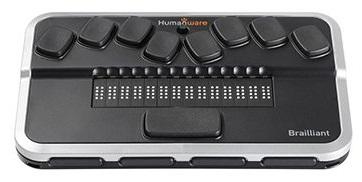Braille display
A brief overview of types of braille displays
Braille displays currently on the market come in many shapes and sizes. The number of braille cells is a determining factor in price and portability. Typical sizes range between 14 and 40 cells.
The other important defining characteristic is the type of functionality. They can be grouped broadly into three main categories:
- Braille displays
- Notetakers
- Smart braille displays
Braille displays
These devices only work when connected to computers, smartphones and tablets. They allow you to read and navigate any text displayed on the screen of the connected device.
Notetakers
These type of braille displays connect to other devices but also allow stand-alone functionality, such as taking notes. Further, they offer a range of other useful features such as reading mail, streaming music, or loading Android applications of various kinds.
Smart Displays
An emerging category of displays mainly geared towards connecting to other devices while offering limited stand-alone functionality, such as taking notes and loading books from some online services or through a computer.
Compatible formats:
Specific file formats supported depend on the device model, but, generally, the following CELA formats are compatible:
- Braille Ready Format (.brf) - Braille displays that support the option of storing and displaying files locally, without being connected to any external device, will allow opening of files in BRF.
- DAISY text (.zip, Direct to Player - format supported depends on the braille display model)
- ePub
- MS Word
- DAISY audio (depending on the functionality of the braille display, some have the ability to play audiobooks as well)
Further, any text presented on the screen of the connected device can be read with a braille display. For example, text from a webpage, book, or application.
Related tutorials
- How to download an electronic braille book
- An overview of braille devices (external link)
- How to choose a braille display (external link; note the specific information about device models may not be current)
